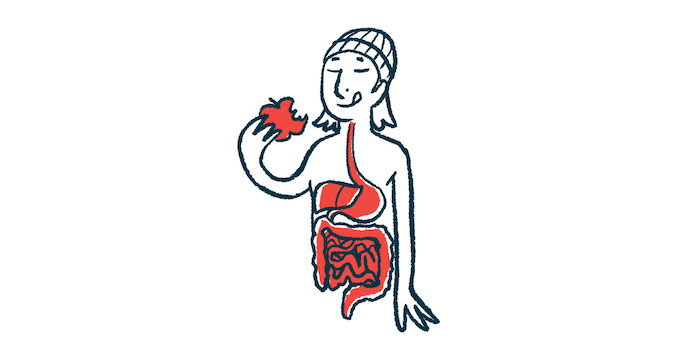Malnutrition may be common in people with systemic scleroderma
Study finds malnutrition in 59.2% of participants, links to heart involvement
Written by |

More than half of the people with systemic sclerosis (SSc) in a study were malnourished under recent French guidelines, one-quarter had severe malnutrition, and being malnourished associated with cardiac involvement, a study in that country reported.
Gastrointestinal (GI) tract involvement, not surprisingly, also was evident in a majority of these people.
“We think the data gathered through this cohort of 120 patients are of interest in an orphan disease such as scleroderma and raises concerns about the risks of malnutrition in this peculiar condition,” the researchers wrote.
As “SSc management is often focalized on life-threatening complications such as interstitial lung disease (ILD),” they added, “precise evaluation of malnutrition is rarely done, and clinical data remain scarce.”
The study, “High prevalence of malnutrition in Systemic Sclerosis: results from a French monocentric cross-sectional study,” was published in the journal Nutrition.
Malnutrition in a disease like SSc rarely focus of study
Systemic sclerosis, or systemic scleroderma, is characterized by the accumulation of scar tissue, or fibrosis, in the skin and internal organs that can include the heart and GI tract.
It’s estimated that more than 90% of people with SSc have GI tract involvement, with the esophagus being most affected, the researchers noted, and this could impact their nutritional status and quality of life.
“However, there is no consensus criteria to define malnutrition yet,” they added, noting that malnutrition estimates in clinical studies range “from 8.3 to 55.6%.”
To evaluate the prevalence of malnutrition among people with SSc, as well as its severity and its impact on the disease, researchers looked at data on 120 adult patients, diagnosed between January 1985 and January 2019 at a hospital’s SSc referral center in Montpellier.
Most patients were women (84%), and the group’s mean age was 64. The majority had GI tract involvement (93%), which was present at the time of diagnosis in 66.7%. GI involvement also mainly affected the esophagus, the tube that carries food from the mouth to the stomach.
On average, GI symptoms preceded an SSc diagnosis by 3.6 months, the researchers noted.
The most frequent symptoms included acid reflux (78% of the patients) — where acid from the stomach flows back to the esophagus — difficulty swallowing (27.5%), diarrhea (25%), constipation (22.5%), and gastroparesis (7.5%), which refers to slow movement, or no movement, of food from the stomach to the small intestine.
French guidelines for malnutrition in SSc look at recent weight loss, BMI
According to French criteria for malnutrition in SSc patients established in 2020, most patients (71 of 120 or 59.2%) had malnutrition, with 25% fulfilling criteria for severe malnutrition. These criteria include a weight loss of 5% or more in one month, 10% in six months, or a body mass index (BMI), a measure of body fat, lower than 21 kg per square meter (21 kg/m2).
A BMI under 21 kg/m2 was observed in about half of the patients (50.8%), and significant weight loss occurred in 14 patients (11.7%). In addition, low blood levels of the protein albumin — also a criterion for of malnutrition in French guidelines — was found in 31 patients (25.8%).
In general, patients with malnutrition under these guidelines also were at a higher risk of malnutrition under the Malnutrition Universal Screening Tool (MUST) scores. This tool takes into account weight loss and BMI, as well as whether patients are likely to have no nutritional intake for five or more days.
According to the MUST score, 41.7% of the patients were at a low risk for malnutrition, 20% at a medium risk, and 38.3% at a high risk. All GI symptoms, except for fecal incontinence, were frequent in malnourished patients.
A “high prevalence of malnutrition in SSc patients associated with a high GI involvement rate,” the researchers wrote.
“Weight loss seems to be strong prevalence upon [malnutrition] and probably even before diagnosis, which claims for an early screening [for malnutrition] upon SSc diagnosis,” they added.
Specific cardiac involvement evident in 12.5% of these patients
A multivariate analysis found an association between specific heart involvement and malnutrition in SSc patients, using both French criteria and MUST scores. In total, 15 patients (12.5%) had heart involvement, with pericarditis/pericardial effusion — fluid buildup in the pericardium, a sac surrounding the heart — in seven people (5.8%); cardiac failure in three (2.5%), and others with myocarditis (inflammation and damage to heart muscle) and arrhythmias.
A smaller mouth opening, or an interincisal distance lower than 35 mm, also significantly correlated with severe malnutrition. Interincisal distance is the distance between the upper and lower jaw, a measure of maximum mouth opening.
Despite limited data, the researchers found severe nutrition in three of four patients with antifibrillarin antibodies, which are associated with internal organ involvement in SSc.
“Our study also identified relevant factors associated to malnutrition, such as microstomia [small mouth aperture] and cardiac involvement, and some red flags for severe malnutrition such [as] interincisal distance under 35 mm and anti-fibrillarin antibodies,” the researchers concluded.
They noted a study limitation was its retrospective use of patient data from a single SSc referral center, so that findings cannot be generalized across this disease. Its results need to be confirmed in studies using larger groups of patients and assessing other factors associated with nutrition.
These researchers are conducting a two-year observational clinical trial (NCT04301596) to assessing the nutritional status of up to 150 adults with SSc at Montpellier University Hospital.






